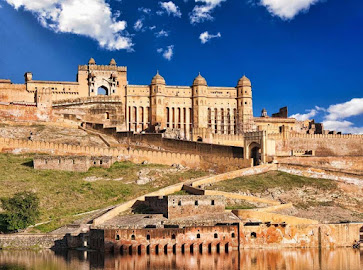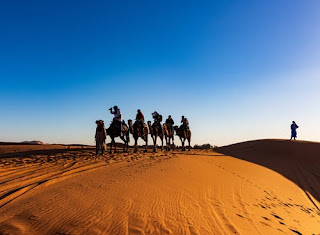The Amer Fort, situated on the top of the Aravalli hill, at a distance of about 11 km from Jaipur, is one of the important and largest forts of Rajasthan. This fort is famous for its unique architectural style and magnificent structure. It is also one of the major tourist places in Rajasthan.
Given its attractive design and grandeur, this fort has been included in the list of World Heritage. One of the main attractions of Rajasthan, the Amer Fort was built by Raja Man Singh. This unique fort made of Hindu-Rajputana architecture is a unique specimen of rich history and grand architecture.
Built-in Hindu-Rajputana architecture, the Amber Fort is one of the largest forts in Rajasthan, which is situated on the Aravalli hills, at a distance of about 11 km from Jaipur. On the other hand, if we look at the history of Amer and the construction of this fort, it is known that Amer has previously been the capital of the Suryavanshi Kachwahas, which was built by a tribe named Minas.
According to historians, this largest fort of Amber in Rajasthan was built by Raja Mansingh I in the 16th century. After which the successors and rulers of Raja Mansingh did the work of expansion and renovation of this fort for about 150 years.
After this, in the year 1727, the Sawai Jai Singh II regime shifted its capital from Amber to Jaipur during his reign, at which time Jaipur was recently established. Let us tell you that before Jaipur, Amber was the capital of the Kachwaha (Maurya) dynasty. One of the oldest forts in India, the Amber Fort, formerly known as Kadima Mahal, also houses the famous temple of Sheela Mata Devi, which was built by Raja Man Singh.
Some people believe that this fort was named after Ambikeshwar, the name of Lord Shiva. Whereas, some people consider the name of Amer Fort as such that the name of this fort is derived from Amba, the name of Maa Durga.
In this most famous and grand fort of Rajasthan, many historical structures were destroyed inside the fort during the times of different rulers, and many new magnificent buildings were built, but despite facing many disasters and obstacles, today it is the name of Amer. The fort is enhancing the pride of Rajasthan and reminds us of its glorious and rich history.
Situated at a distance of about 11 km from Jaipur, this huge fort of Rajasthan has been constructed in Hindu and Rajputana styles. Looking at this fort from the outside, it appears to be influenced by Mughal architecture, while from the inside this fort is built in Rajput architectural style.
This fort is a unique example of Mughal and Hindu architecture. Inside this fort are pictures of famous and courageous Rajput rulers of ancient architecture and history. Historical palaces, gardens, reservoirs, and beautiful temples built inside this huge fort double its beauty.
Tourists enter the Amer Fort of Rajasthan through the entrance built to the east of this fort, this gate is the main gate of the fort, which is called Surpol or Surya Dwar, the name of this gate is taken from the rising of the sun located in the east. . At the same time, there is a grand gate in the south inside this fort, which is known as Chandrapol Dwar. Jaleb Chowk is built right in front of this gate. From where the tourists enter the courtyard of the palace.
Let us tell you that the Jaleb Chowk of Amer Fort was earlier used by the army to re-display their wartime, which women could see only from their windows. Stairs are visible on two sides from Jaleb Chowk, out of which the stairs on one side lead to Shila Mata Temple, the Kul Devi of Rajput kings.
This temple is established in the sanctum sanctorum of this grand fort, which has historical importance as well as its own religious importance, while tourists who come to visit Amer Fort definitely visit this temple. At the same time, the stairs on the other side, visible from Jaleb Chowk of this fort, led to the Singhpol gate.
At the same time, near this gate, a very attractive structure remains the Diwan-i-Aam, where earlier emperors held a court for the general public, in which their pleas were heard. Ganesh Pol Dwar is situated on the south side of this grand fort built of yellow, and red sand, and marble stones, which is the most attractive and beautiful gate of this fort. Excellent carvings and splendid workmanship have been done at this gate.
At the same time, a small idol of Lord Ganesha is adorned above this door, hence this gate of Amer Fort is called Ganesh Dwar. There are many historical and very attractive structures, including Diwan-e-Khas, Sukh Mahal, and Sheesh Mahal, when going inside this royally designed fort of Rajasthan. Amazing artwork is also seen in these structures of the fort.
Along with this, this grand fort, included in the list of World Heritage, also has a beautiful garden made of a Charbagh style, which is making the beauty of this fort even more beautiful by spreading its natural shade. This oldest Rajputana heritage of Rajasthan is also connected to Jaigarh Fort through a tunnel route of about 2 km long.
This tunnel was constructed to take the families of emperors to Jaigarh fort in case of emergency. A very beautiful view of Jaigarh Fort and its surroundings is visible from near this fort. A huge number of tourists visit every year to see the beauty and grandeur of Amer Fort, one of the most important and famous forts of Rajasthan.
To visit any place in India connect me.
mansur29029@gmail.com

























